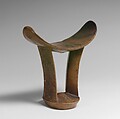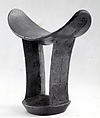Headrest
Not on view
Subtle, curvilinear forms are combined with intricate, incised patterns in this exquisite headrest from eastern Africa. With a crescent-shaped upper platform, small circular or oval base, and two flattened supporting columns, is this style of headrest is found among the nomadic Somali of both southern Somalia and eastern Kenya.
Headrests are used by both Somali men and women while resting or sleeping. It is popularly believed that the headrest serves a protective function by elevating the head off the ground during sleep, thereby preventing any possible attack by snakes or scorpions. Men's headrests, such as this one, generally feature a smaller base that makes them somewhat unstable to sleep on, while the rectangular bases of women's headrests are usually more stable. Scholars suggest that this instability is purposeful as it prevents the user from falling into a deep sleep while guarding the herds at night. It is in this sense that the headrest itself has become a symbol of vigilance among Somali nomads. In this example, the surface decorations of both supports are identical and feature interlaced rope motifs on the top and bottom interrupted by a honeycomb-like relief in the middle. The patterns on this and many other Somali headrests probably reflect the Islamic influence in the region. Some scholars interpret the patterns and iconography as a "form of shorthand for a prayer," to ensure God's protection of the sleeper. Headrests also play an important role in the nuptial ceremonies of Somali nomads. On his wedding night, the groom places the tubash (a sum of money) under the bride's headrest. The morning after the marriage is consummated, the bride will use this money to purchase an amber necklace, the symbol of her new status.
The headrests are carved from a single piece of fine-grained wood known as hagar in Somali, or also yucub wood. The wood is usually left its natural color, but is sometimes painted red or black by its owner. Somali nomads also make use of another type of headrest with a single cylindrical supporting column. It appears that the different styles are for men of different status, with the single-columned variety for young men and the double-columned variety, as seen here, reserved for elders.
Due to rights restrictions, this image cannot be enlarged, viewed at full screen, or downloaded.
This artwork is meant to be viewed from right to left. Scroll left to view more.



